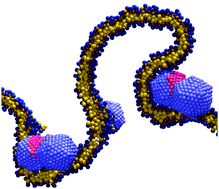Multiscale modeling of emergent materials: biological and soft matter
Abstract
In this review, we focus on four current related issues in multiscale modeling of soft and biological matter. First, we discuss how to use structural information from detailed models (or experiments) to construct coarse-grained ones in a hierarchical and systematic way. This is discussed in the context of the so-called Henderson theorem and the inverse Monte Carlo method of Lyubartsev and Laaksonen. In the second part, we take a different look at coarse graining by analyzing conformations of molecules. This is done by the application of self-organizing maps, i.e., a neural network type approach. Such an approach can be used to guide the selection of the relevant degrees of freedom. Then, we discuss technical issues related to the popular dissipative particle dynamics (DPD) method. Importantly, the potentials derived using the inverse Monte Carlo method can be used together with the DPD thermostat. In the final part we focus on

- This article is part of the themed collections: Coarse-grained modeling of soft condensed matter and Highlighting Canadian research in PCCP

 Please wait while we load your content...
Please wait while we load your content...